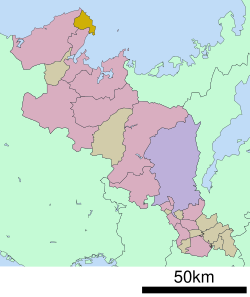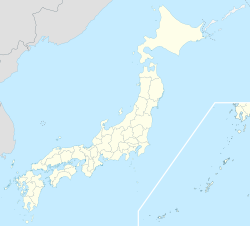Ine, Kyoto
|
Ine 伊根町 |
|||
|---|---|---|---|
| Town | |||

View of Ine
|
|||
|
|||
 Location of Ine in Kyoto Prefecture |
|||
| Location in Japan | |||
| Coordinates: 35°41′N 135°17′E / 35.683°N 135.283°ECoordinates: 35°41′N 135°17′E / 35.683°N 135.283°E | |||
| Country | Japan | ||
| Region | Kansai | ||
| Prefecture | Kyoto Prefecture | ||
| District | Yosa | ||
| Government | |||
| • Mayor | Yoshimoto Hideki | ||
| Area | |||
| • Total | 61.98 km2 (23.93 sq mi) | ||
| Population (April 1, 2017) | |||
| • Total | 2,188 | ||
| • Density | 35/km2 (91/sq mi) | ||
| Symbols | |||
| • Tree | Japanese Black Pine | ||
| • Flower | Chrysanthemum | ||
| Time zone | Japan Standard Time (UTC+9) | ||
| Website | www |
||
Ine (伊根町? Ine-chō) is a town located in Yosa District, Kyoto Prefecture, Japan. The Tango Peninsula was a trade route from Eurasian Continent to Kyoto.
It is famous for wooden fishing houses called funaya, selected as Groups of Traditional Buildings. Tsutsukawa district and Honjo-Hama district have been handed down Urashima Tarō legend.
As of April 2017, the town has an estimated population of 2,188. The total area is 61.98 km².
Ine was founded on November 3, 1954 by the merger of four villages.
Located on the coast of the Sea of Japan on the northeast side of the Tango Peninsula in the northwestern corner of the prefecture.
Ine is governed by mayor Yoshimoto Hideki, an independent. The city assembly has 10 members.
An total annual a catch is 3,190 tons, account for 25 percent of all a catch in Kyoto Prefecture.
...
Wikipedia



